Daily Business Report-Oct. 27, 2015
Sam Kassegne, deputy director for the CSNE at SDSU and a professor in the mechanical engineering department.
Renewed Hope for the Brain-Injured;
SDSU receives renewed funding from NSF
One day soon, people who suffer traumatic injury to their spinal cord and lose the use of their limbs could regain that mobility thanks to a clever workaround: a brain chip that reroutes neural signals around the injured nerves combined with a receiver that picks them up on the other side.
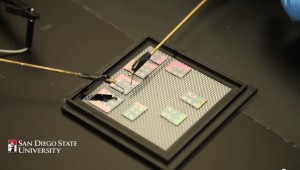
This work is getting closer to reality in the Center for Sensorimotor Neural Engineering (CSNE), led by researchers at San Diego State University, the University of Washington and the Massachusetts Institute of Technology.
To help usher along this ambitious and much-needed technology, the National Science Foundation recently renewed funding for the CSNE, providing an additional $15 million to $20 million over the next five years.
Using implantable chips in the brain is an important and growing trend in medical science, said Sam Kassegne, deputy director for the CSNE at SDSU and a professor in the mechanical engineering department. In the United States alone, there are more than 100,000 people who have brain-implanted electrodes to help manage a number of diseases and conditions including Parkinson’s disease and chronic depression.
Think of the ability to use implantable electrodes to restore motor function as installing a detour in the brain-to-body communication system.
“Neural signals are electrical in nature,” Kassegne said. “When the brain or spinal cord is damaged, those electrical signals can’t get through. There’s nothing wrong with the signal, but it’s being blocked.”
Electrodes can listen to these electrical signals where they originate in the brain — “decoding the intent to use the limb,” as Kassegne puts it — then feed that information into a device that converts the electrical signal into a wireless transmission. A receiver in the functionally paralyzed limb picks up that information, converts it back into the original electrical signal as accurately as possible and stimulates the nerves, restoring function.
__________________________________________________

Former Midway Post Office
Building Sells for $19.3 Million
Rexford Industrial Realty Inc.. a real estate investment trust based in Los Angeles, has acquired the former main post office on Midway Drive for $19.3 million or $52 per square foot.
The property at 2535 Midway Drive is comprised of two buildings containing 373,000 rentable square feet on 16.05 acres of land.
The company intends to reconfigure the ground floor of the two buildings into 10 industrial units of 10,000 to 45,000 square feet. The second phase would reconfigure 144,000 square feet on the second floor. Completion is expected in 18 months.
CareFusion Signs Distribution Deal With
AAM Healthcare for Video Laryngoscope
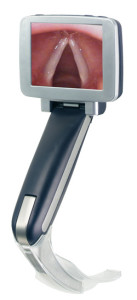
San Diego-based CareFusion announced that its Vital Signs anesthesia delivery and patient monitoring business has entered into an exclusive agreement with AAM Healthcare to distribute its APA video laryngoscope in the U.S. and 12 other countries.
The APA video laryngoscope is a handheld, portable device to aid in tracheal intubation. Inspired and designed by clinicians, this is an all-in-one device for both routine and rescue airways that offers interchangeable Macintosh (MAC) and Difficult Airway Blades (DAB). The APA video laryngoscope is the first device of its kind to incorporate video into the practice of standard laryngoscopy.
Video laryngoscopy can improve first time intubation compared to standard intubations and can be five times less likely to need to perform an oesophageal intubation.
The product was first introduced by Vital Signs at the European Society of Anesthesia in June 2015 in Berlin, Germany. The product is commercially available through CareFusion in the United States, France, Spain, Norway, Denmark, Iceland, Finland, Sweden, United Kingdom, Ireland, Japan, Australia and New Zealand.
Bumble Bee Seafoods Adds Online
Tracking Ability for Its Tuna Products

Bumble Bee Seafoods has launched a traceability feature on its website that enables consumers to track the source of their tuna product from catch to can by entering a code found on their can or pouch.
The traceability page, BumbleBee.com/TraceMyCatch, will educate consumers on the path their tuna takes in order to get from the ocean to their plate. Upon entering a code from the package, the site will display information specific to the product including species, fishing method, ocean of catch, vessel names and flags, fishing trip dates and processing location.
“Transparency is increasingly important to consumers who want to know where their food comes from and Bumble Bee is committed to meeting these expectations,” said Chris Lischewski, Bumble Bee president and CEO. “We have always had the ability to trace our products to their source and this site brings that information direct to consumers.”
Consumers can visit BumbleBee.com/TraceMyCatch, enter the production code found on the bottom of cans and back of pouches, and view the results on Bumble Bee’s visual and interactive site. For consumers without a current traceable code, sample codes are provided for similar tuna products that allow visitors to interact with the site and learn about the process.
“The tuna supply chain is expansive with data being collected from nearly 600 vessels operating in four oceans across the globe,” said Lischewski.
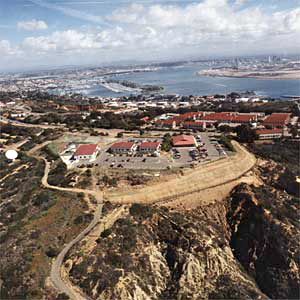
Navy Awards $26 Million Contract for
Work at Naval Health Research Center
Leidos, a health, national security, and engineering company, was awarded a contract by the U.S. Navy to provide operational medicine research modeling support services to the Naval Health Research Center in San Diego. The single-award cost-plus fixed-fee contract has a one-year base period of performance, four one-year options, and a total contract value of approximately $26 million, if all options are exercised.
NHRC performs medical modeling and simulation research for the Department of Defense, homeland defense, humanitarian assistance, peace-keeping and disaster relief activities, including casualty projection, medical planning factor development, identification of weapons effects both ground and shipboard-based, projection of resource requirements, database development and maintenance, and quality of life outcome studies. The Naval Health Research Center in Point Loma
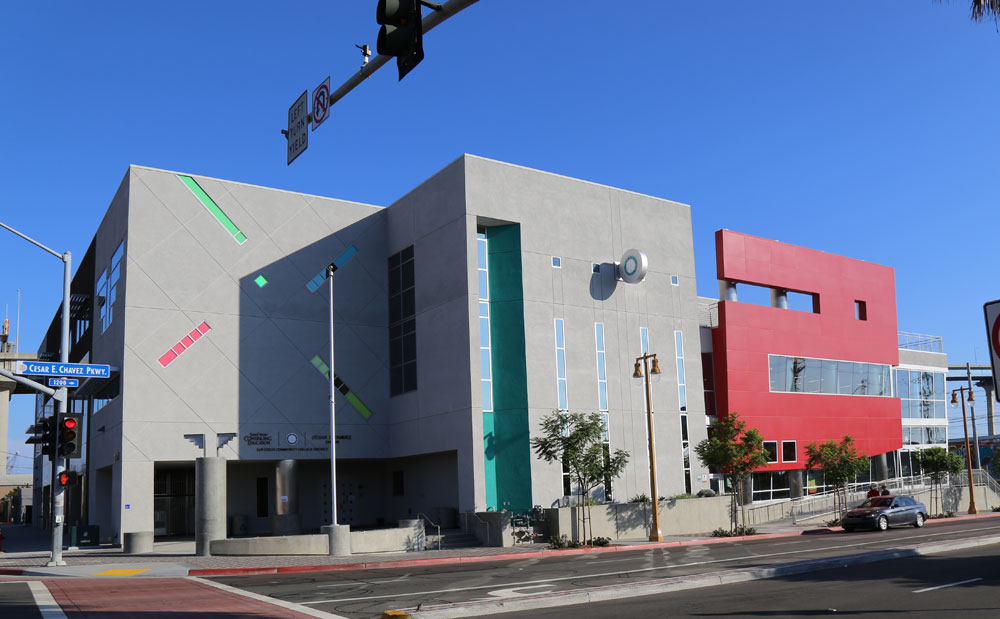
Continuing Ed Opens César E. Chávez
Campus to Barrio Logan Community
San Diego Continuing Education will hold a grand opening celebration of its newest educational facility and campus car park on Wednesday. The project consists of a 67,924-square-foot, three-story César E. Chávez Campus building with an underground, 149-car parking area; plus a detached campus car park with 320 additional spaces and murals featuring the life and work of César E. Chávez that is located two blocks east of the campus.
The $58 million facility and car park is San Diego Continuing Education’s final bond-funded new construction.
A program will be held at 10 a.m. at 1901 Main St., San Diego.
The facility houses 22 classrooms for vocational training, English as a Second Language, Citizenship, Adult Basic Education, high school equivalency preparation classes, business and information technology, parent education and Emeritus (age 55+) programs. The new building also includes a multipurpose room, administrative offices, and space for the Entrepreneurship and Small Business Management Program.
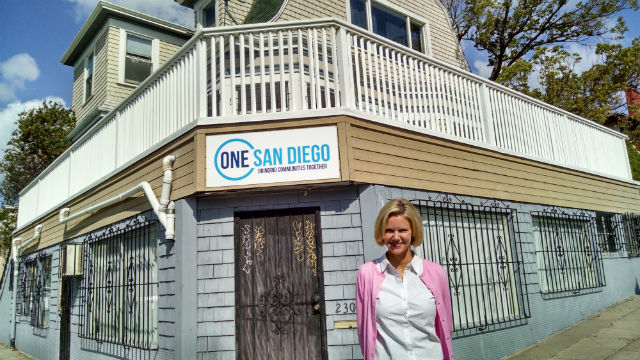
One San Diego Seeks to Bridge
City’s North-South Divide
Times of San Diego
From a small office in San Diego’s Golden Hill neighborhood, Mayor Kevin Faulconer’s year-old nonprofit One San Diego is trying to bridge the gap between the city’s wealthiest and most impoverished neighborhoods.
“One San Diego was really one of Kevin’s campaign platforms. His whole concept is that every neighborhood has to be doing well if San Diego is going to do well,” said his wife, Katherine, who serves as honorary chair of the nonprofit.
The organization’s office is in an old building with graffiti on the door. That’s on purpose to underscore a commitment to address what Faulconer calls “the divide between the communities north of the ‘8’ versus south of the ‘8.’”
Faulconer sees her role as fostering partnerships that bring together companies and other sponsors to provide very specific kinds of help to San Diego neighborhoods. And in her role as first lady of the city, she has many opportunities to see where help is needed.
“We’ll find a sponsor who wants to do something and we’ll sit down with them and create a program,” she explained. “There’s plenty of things that need help funding.”
Over the last year, One San Diego’s neighborhood projects have included:
• November 2014 — Provide 60 laptops for students to do homework at public libraries. Funding was provided by the Walmart Foundation and the San Diego Public Library Foundation.
• August 2015 — Distributed 300 backpacks filled with school supplies to low-income students in Barrio Logan in partnership with the Marlow B. Martinez Foundation.
• August 2015 — Organized a block party for residents of Southcrest with police officers and firefighters on hand in an effort to increase neighborhood cooperation.
• September 2015 — Provided 60 Chromebook laptops for use by students in the San Ysidro and Valencia Park/Malcolm X Branch libraries. Funding came from Cox Communications and the San Diego Library Foundation.
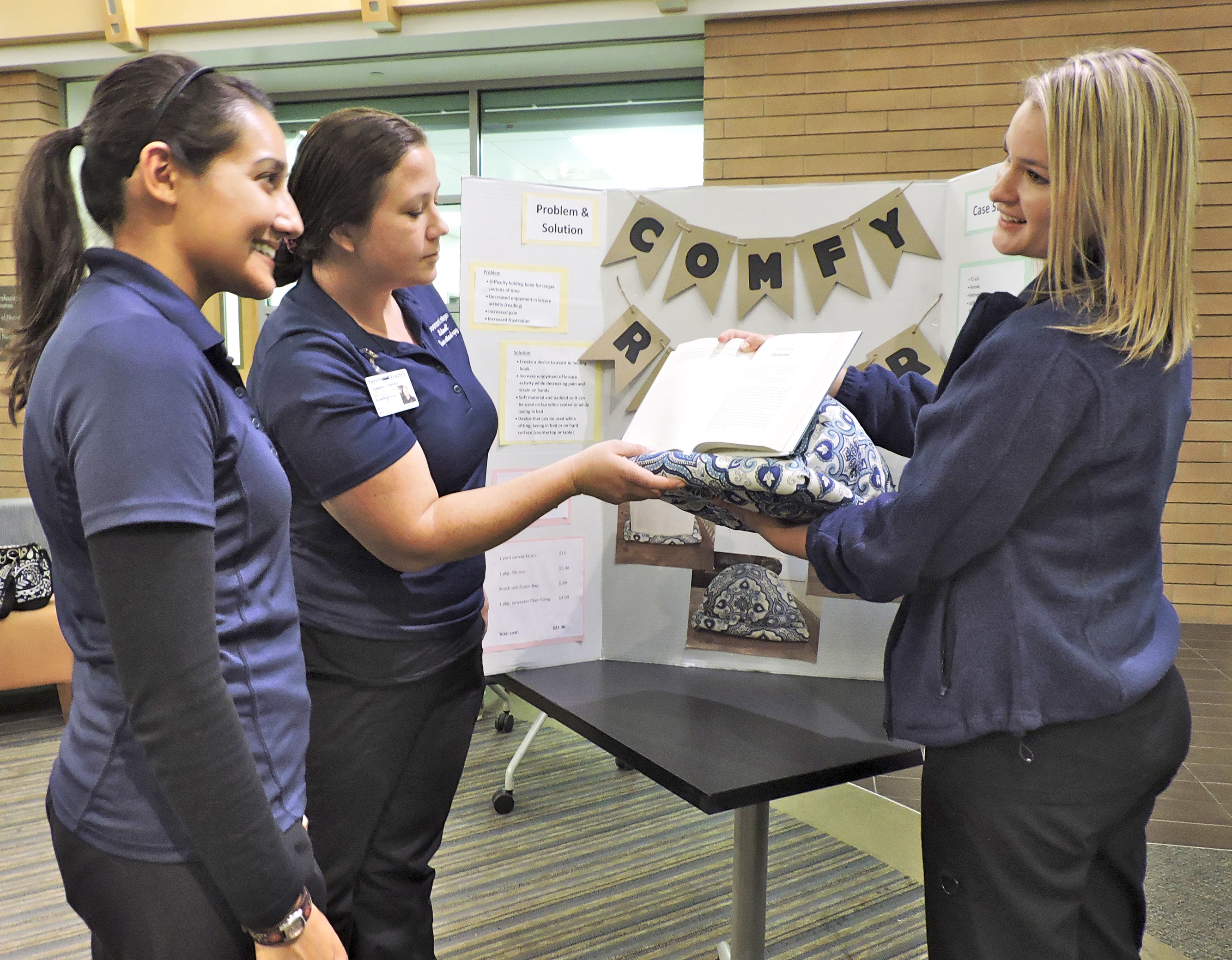
Grossmont College Class Creates Novel
Devices to Help the Physically Impaired
Students in a Grossmont College Occupational Therapy Assistant class have become inventors, creating homemade adaptive devices to help make life a little easier for friends and family members with physical impairments.
The 19 students will demonstrate their creations during the OTA program’s Eighth Annual Assistive Technology Show from 6:30-8 p.m. Thursday, Nov. 5, in the upper and lower lobbies of Building 34, the Health and Sciences Complex at Grossmont College, 8800 Grossmont College Drive in El Cajon.
During a recent practice run for the show, the students taking instructor Darlene Cook’s assistive technology course brought their projects to class and gave five-minute presentations, explaining the origins of their devices and how they work, the materials used, and the labor and cost of their handiwork. As each demonstration ended, classmates peppered the students with questions, while a panel of four other students provided written critiques and scores.
The students in the class are training in the two-year program to work under the supervision of an occupational therapist to provide patient treatment to people whose abilities to perform everyday tasks are threatened or impaired by developmental deficits, aging, mental health problems, physical injury or illness. OTAs are employed in hospitals, rehabilitation facilities, skilled nursing facilities, schools, day treatment centers, outpatient clinics and other community agencies.
Some of the OTA students in Cook’s class set up display boards with photos of their “clients” using the devices that the students not only created, but also named. The devices, all under $25, were and constructed with common, household materials. One of them was Comfy Reader, a pillow-like book rest that a student’s 71-year-old grandmother could hold in her lap or place on a table or bed. Osteoarthritis and a decreased grip strength made holding books with her hands too difficult, the student explained.
Another was Gotcha Gloves, a pair of knitted gloves with Velcro on the palm side that makes grasping and holding items easier for a student’s 6-month-old nephew, a stroke patient in recovery. Born with a congenital heart defect, the tot had developed a clot after undergoing surgery that doctors say caused the stroke.
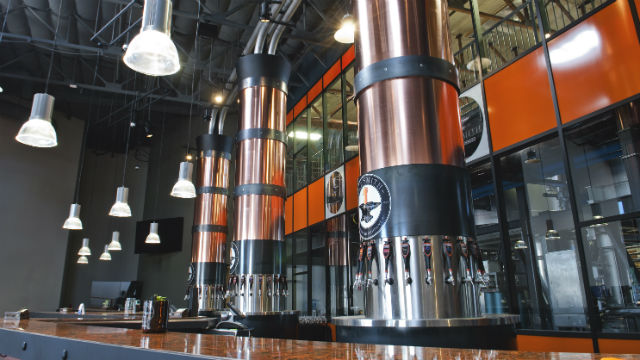
AleSmith Opens San Diego’s
Largest Craft Beer Tasting Room
Times of San Diego
AleSmith Brewing Company has opened a new, 25,000-square-foot tasting room in Miramar that is believed to be the largest in the San Diego.
The indoor-outdoor space includes a zigzagging bar and three massive copper tap towers, all with a view of the two-story brewhouse.
“Our twentieth year has been momentous with us moving into a much larger facility that will allow us to increase our production ten-fold,” said owner and CEO Peter Zien. “But the biggest thrill for us in this process is being able to provide a world-class place to share our beer with the fans who played such a vital role in making AleSmith what it has become.”
AleSmith’s original tasting room comprised 750 square feet of space and featured a single set of 15 taps. The new venue is equipped with 60 taps.
The craft brewer plans to add a beer garden, upstairs mezzanine area, company store, private event space and a museum honoring the memory of San Diego Padres great Tony Gwynn.
Personnel Announcements
Cavignac & Associates Names Risk Control Adviser
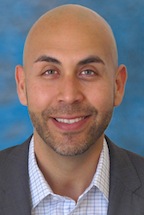
Joe Rojas has been named a risk control adviser at Cavignac & Associates. Rojas has overall responsibility for evaluating and delivering risk control and safety strategies designed to lower clients’ overall cost of risk. Specifically, he will be the liaison with local, state and federal regulatory agencies on safety- and health-related issues.
Rojas has seven years of experience in the areas of risk management, health and safety. Previously he served as a senior loss control consultant for Keenan & Associates in Torrance, where he was charged with identifying client risk exposures, advising on resolution strategies and reviewing clients’ safety programs. During the four years prior, he was the senior health and wellness coach for Wellness Coaches USA in Los Angeles.

